-

高教版中职数学基础模块下册:7.1《平面向量的概念及线性运算》教学设计
教 学 过 程教师 行为学生 行为教学 意图时间 *揭示课题 7.1 平面向量的概念及线性运算 *创设情境 兴趣导入 如图7-1所示,用100N①的力,按照不同的方向拉一辆车,效果一样吗? 图7-1 介绍 播放 课件 引导 分析 了解 观看 课件 思考 自我 分析 从实例出发使学生自然的走向知识点 0 3*动脑思考 探索新知 【新知识】 在数学与物理学中,有两种量.只有大小,没有方向的量叫做数量(标量),例如质量、时间、温度、面积、密度等.既有大小,又有方向的量叫做向量(矢量),例如力、速度、位移等. 我们经常用箭头来表示方向,带有方向的线段叫做有向线段.通常使用有向线段来表示向量.线段箭头的指向表示向量的方向,线段的长度表示向量的大小.如图7-2所示,有向线段的起点叫做平面向量的起点,有向线段的终点叫做平面向量的终点.以A为起点,B为终点的向量记作.也可以使用小写英文字母,印刷用黑体表示,记作a;手写时应在字母上面加箭头,记作. 图7-2 平面内的有向线段表示的向量称为平面向量. 向量的大小叫做向量的模.向量a, 的模依次记作,. 模为零的向量叫做零向量.记作0,零向量的方向是不确定的. 模为1的向量叫做单位向量. 总结 归纳 仔细 分析 讲解 关键 词语 思考 理解 记忆 带领 学生 分析 引导 式启 发学 生得 出结 果 10
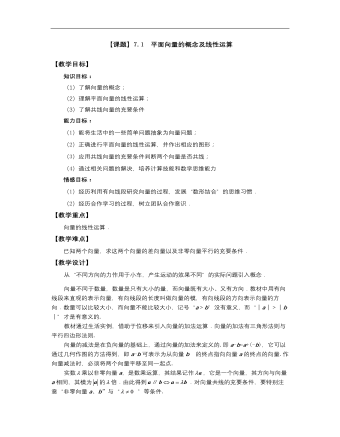
高教版中职数学基础模块下册:7.1《平面向量的概念及线性运算》教学设计
教 学 过 程教师 行为学生 行为教学 意图时间 *揭示课题 7.1 平面向量的概念及线性运算 *创设情境 兴趣导入 如图7-1所示,用100N①的力,按照不同的方向拉一辆车,效果一样吗? 图7-1 介绍 播放 课件 引导 分析 了解 观看 课件 思考 自我 分析 从实例出发使学生自然的走向知识点 0 3*动脑思考 探索新知 【新知识】 在数学与物理学中,有两种量.只有大小,没有方向的量叫做数量(标量),例如质量、时间、温度、面积、密度等.既有大小,又有方向的量叫做向量(矢量),例如力、速度、位移等. 我们经常用箭头来表示方向,带有方向的线段叫做有向线段.通常使用有向线段来表示向量.线段箭头的指向表示向量的方向,线段的长度表示向量的大小.如图7-2所示,有向线段的起点叫做平面向量的起点,有向线段的终点叫做平面向量的终点.以A为起点,B为终点的向量记作.也可以使用小写英文字母,印刷用黑体表示,记作a;手写时应在字母上面加箭头,记作. 图7-2 平面内的有向线段表示的向量称为平面向量. 向量的大小叫做向量的模.向量a, 的模依次记作,. 模为零的向量叫做零向量.记作0,零向量的方向是不确定的. 模为1的向量叫做单位向量. 总结 归纳 仔细 分析 讲解 关键 词语 思考 理解 记忆 带领 学生 分析 引导 式启 发学 生得 出结 果 10

人教版高中地理选修2三峡工程对生态环境和名胜古迹的影响及对策教案
一、三峡工程的生态环境效应三峡工程的生态环境效应是指建设三峡工程对生态与环境的有利和不利影响。1、有利影响(1)防洪:(2)防治血吸虫病:(3)减轻洞庭湖淤积(4)增加枯水期流量,改善水(5)调节局部气候:(6)减轻环境污染:综上所述,三峡工程对生态环境的有利影响主要在中下游。2、不利影响及措施(1)淹没土地、耕地:水库蓄水将淹没土地、耕地。(2)加剧水土流失和环境污染:在移民开发和城市迁建过程中,处理不当可能产生新的水土流失和环境污染等问题。(3)诱发地质灾害(地震、滑坡):水库蓄水改变了原有地应力的平衡,可能诱发地震,并使库岸发生滑坡等地质灾害的可能性增大。(4)加重泥沙淤积:水库蓄水,使库区水流速度变慢,库区和库尾的泥沙淤积加重。

新人教版高中英语必修2Unit 2 Wildlife Protection-Discovering Useful Structure教案二
2.表示现阶段正在进行的被动动作(该动作在说话的瞬间未必正在进行)。Many interesting experiments are being carried out these days.(说话时,并不一定正在进行)3.表示一种经常性的被动行为,常和always,constantly 等表示频度的副词连用,这种用法常常带有赞扬或厌恶的感情色彩。He is always being praised by the leader.4.表示按计划或安排主语将要承受谓语动词所表示的动作(仅限于少数及物动词)。A party is being held tonight.Step 4 Special cases1.像take care of, look after, talk about, think of等动词与介词构成的短语用于现在进行时的被动语态时, 其中的介词不可省略。The ways to stop illegally hunting are being talked about. 2.可与部分情态动词连用,表示对正在发生的事情的推测。She may be being punished by her mother.3.有时可表示按计划或安排将要进行的一个被动动作。A celebration is being held this weekend for his success.4.某些表示“状态、心理活动、存在”等的动词,如have,want,need,love,一般不用现在进行时的被动语态,而常用一般现在时的被动语态。With the population increasing,more land is needed.5.“be+under/in+n.”可表示现在进行时的被动意义。My computer is under repair.=My computer is being repaired.

新人教版高中英语必修2Unit 2 Wildlife Protection-Discovering Useful Structure教案一
The activity topic of this section is "report an ongoing event", and the structure is the passive voice of present continuous tense. Rare wild animals are suffering from large-scale poaching, and species are on the brink of danger. Rescue operations are underway. "Being" and "suffering" are the meanings of the present progressive passive voice.The usage of present progressive passive voice is of great importance in writing a good discourse and appreciating some difficult language items, so it is vital to master it and use it flexibly in a context.1. Motivate Ss to deepen the understanding of the usage of present progressive passive voice in a fixed context.2. Enable Ss to master the usage of present progressive passive voice and use it flexibly in a context.3. Lead Ss to construct sentences or appreciate sentences used master it and use it flexibly in a context.1. Help students to appreciate the function of the usage of present progressive passive voice in a sentence2. Instruct students to write essays using the proper usage of present progressive passive voice.Look at the picture and tell me what are workers doing? What is the house being done?

新人教版高中英语必修2Unit 1 Cultural Heritage-Discovering Useful Structure教案二
This theme of the part is “ Describe people or things in greater detail”. Students have learned the grammar(restrictive relative clauses) in Book 1, and further review and consolidate its structure “prep+relative pronouns(which/whom)” and the relative adverbs(when, where and why), besides students should understand its form, meaning and functions. In this section, students should be able to express the grammar correctly in daily communication and in the writing. 1. Review the basic usages of relative pronouns and adverbs of attributive clauses . 2. Learn to use some special cases about restrictive relative clauses.3. Learn to write sentences with restrictive relative clauses flexibly according to the context.1. Review the basic usages of relative pronouns and adverbs of attributive clauses .2. Learn to use some special cases about restrictive relative clauses.3. Learn tow rite sentences with restrictive relative clauses flexibly according to the context.Step 1. Observe the following sentences, and mark the relative pronouns and the adverbs. 1. After listening to the scientists who had studied the problems, and citizens who lived near the dam, the government turned to the United Nations for help.2. Temples and other cultural sites were taken down piece by piece, and then moved and put back together again in a place where they were safe from the water.Step 2 PracticePlease complete these sentences with relative pronouns and relative adverbs and answer the following questions.Questions: 1. What is the head noun ?2. What relative words should be used ?3. What elements do they act in these sentences ?

新人教版高中英语必修2Unit 1 Cultural Heritage-Discovering Useful Structure教案一
This teaching period mainly deals with grammar “restrictive relative clauses.” To begin with, teachers should lead students to revise what they have learned about the relative pronouns and relative adverbs. And then, teachers move on to stress more special cases concerning this grammar, such as the “preposition+ relative pronouns which and whom” and cases where we can omit the relative pronouns. This period carries considerable significance to the cultivation of students’ writing competence and lays a solid foundation for the basic appreciation of language beauty. The teacher is expected to enable students to master this period thoroughly and consolidate the knowledge by doing some exercises. 1. Guide students to review the basic usages of relative pronouns and adverbs of attributive clauses.2. Lead students to learn to use some special cases concerning restrictive relative clauses flexibly.2. Enable students to use the basic phrases structures flexibly.3. Strengthen students’ great interest in grammar learning.1. Help students to appreciate the function of relative pronouns and adverbs of attributive clauses in a sentence2. Instruct students to write essays using the proper relative pronouns and adverbs of attributive clauses.本节语法思考:定语从句在复合句中的作用是什么? 关系词有哪些?定语从句在复合句中的作用相当于形容词,它在句中作定语修饰名词或代词。他们在先行词和定语从句之间起到联系作用,同时在意义上代表先行词并在定语从句中担任一个成分。被定语从句所修饰的词称先行词,定语从句一般放在先行词的后面。

新人教版高中英语必修2Unit 4 History and Traditions-Discovering Useful Structure教案一
Step 5 Practice一、完成下列句子。1. Judy and I _______________(把车停下来(park))in an underground car Park near Trafalgar Square, where we could ______________________(让我们的车充电(charge)).2. When we finally reached the service desk to ask for audio guides, we heard it ___________ that there were no audio guides____________(留下,剩下).3. We__________________________(发现自己对...很惊讶)the large number of visitors and the amount of noise at the entrance of the National Gallery.4. Judy ____________________(眼神专注于) Van Gogh’s Sunflowers. It was hard to approach the painting as there were so many people around.5. She ____________________(把这幅画的复制品装箱(box)) to ensure that it was delivered safely.答案:1.had our car parked get our car battery charged 2. announced left 3. found ourselves very surprised 4. had her eyes fixed on 5. had a copy of the painting boxed二、用过去分词对下列句子进行改写。1. Loch Ness was surrounded by beautiful natural landscape, which made it look amazing.2. Carl and his friend stayed with a generous family who offered them bread with butter and honey that was homemade.3. The family’s ancestors once attended to soldiers who were wounded in the First World War.4. The young people were attracted by the legend of Loch Ness. They watched over the lake with their cameras and binoculars, which were positioned on the hill.答案:1. Loch Ness surrounded by beautiful natural landscape looks amazing.2. Carl and his friends stayed with a generous family who offered them homemade bread with butter and honey.3. The family’s ancestors once attended to wounded soldiers in the First World War.4. The young people attracted by the legend of Loch Ness watched over the lake with their cameras and binoculars positioned on the hill.

新人教版高中英语必修2Unit 4 History and Traditions-Discovering Useful Structure教案二
This teaching period mainly deals with grammar: The past participle is used as attributive and objective complement.1. Guide students to review the basic usages of the past participle used as attributive and objective complement.2. Lead students to learn to use some special cases concerning the past participle used as attributive and objective complement flexibly.3. Strengthen students’ great interest in grammar learning.1. Help students to appreciate the function of the past participle used as attributive and objective complement.2. Instruct students to write essays using the past participle used as attributive and objective complement.Step1:温故而知新。Analyze the underlined phrases and then sum up the common usages of the past participles.1.(教材P41)They had castles built(build) all around England, and made changes to the legal system.2.(教材P42)They use the same flag, known(know) as the Union Jack,...3.(教材P42)Judy and I had our car parked(park) in an underground car park near Trafalgar Square, where we could get our car battery charged(charge).Common points: f the past participle used as attributive and objective complement.Step 2:过去分词作定语时的意义1.及物动词的过去分词作定语,在语态上表示被动;在时间上,常表示动作已经发生或完成,有时也不表示时间性。Our teacher watched us doing the experiment and gave us a satisfied smile at last.我们的老师看着我们做实验,最后给了我们一个满意的微笑。The plan put forward at the meeting will be carried out soon.会上提出的计划将很快被执行。2.不及物动词的过去分词作定语,它不表示被动意义,只强调动作完成。Many little kids like gathering fallen leaves in the yard.

新人教版高中英语必修1Unit 2 Travelling Around-Discovering Useful Structure教案
(5)be to do (可以和具体的时间状语连用)①表示按计划、安排即将发生的动作。②用于时间、条件状语从句中,表示“如果要……,想要……”。The students are to meet at the school gate tomorrow. 明天学生们将在学校大门口集会。 If you are to succeed, you must work as hard as possible. 如果你想要成功,比必须努力工作。(6)be about to do (不与具体的时间状语连用) 表示即将要发生的动作。We are about to start. 我们就要出发了。The new school year is about to begin. 新学年开学在即。(7)一般现在时表将来①表示按时间表规定将要发生的动作。常限于表示位置移动的短暂性动词。②在时间、条件或让步状语从句中,用一般现在时表将来。Look at the timetable. Hurry up! Flight 4026 takes off at 18:20. 你看看时刻表,快点!4026次航班的起飞时间是下午6点20分。Jane is in a hurry because the train to the airport leaves in half an hour. 简很匆忙,因为去机场的火车半小时后出发。
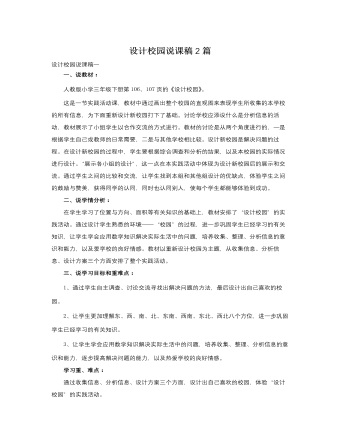
人教版新课标小学数学三年级下册设计校园说课稿2篇
二、说学情分析:在学生学习了位置与方向、面积等有关知识的基础上,教材安排了“设计校园”的实践活动。通过设计学生熟悉的环境──“校园”的过程,进一步巩固学生已经学习的有关知识,让学生学会应用数学知识解决实际生活中的问题,培养收集、整理、分析信息的意识和能力,以及爱学校的良好情感。教材以重新设计校园为主题,从收集信息、分析信息、设计方案三个方面安排了整个实践活动。三、说学习目标和重难点:1、通过学生自主调查、讨论交流寻找出解决问题的方法,最后设计出自己喜欢的校园。2、让学生更加理解东、西、南、北、东南、西南、东北、西北八个方位,进一步巩固学生已经学习的有关知识。3、让学生学会应用数学知识解决实际生活中的问题,培养收集、整理、分析信息的意识和能力,逐步提高解决问题的能力,以及热爱学校的良好情感。
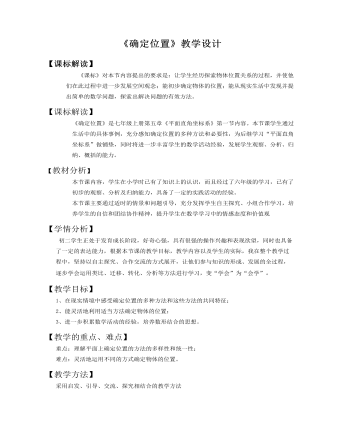
初中数学鲁教版七年级上册《第五章 位置与坐标 1 确定位置》教学设计教案
1、通过同位之间互说座位位置,检测知识目标2、3的达成效果。2、通过导学案上的探究一,检测知识目标2、3的达成效果。 3、通过探究二,检测知识目标1、3的达成效果。 4、通过课堂反馈,检测总体教学目标的达成效果。本节课遵循分层施教的原则,以适应不同学生的发展与提高,针对学生回答问题本着多鼓励、少批评的原则,具体从以下几方面进行评价:1、通过学生独立思考、参与小组交流和班级集体展示,教师课堂观察学生的表现,了解学生对知识的理解和掌握情况。教师进行适时的反应评价,同时促进学生的自评与互评。2、通过设计课堂互说座位、探究一、二及达标检测题,检测学习目标达成情况,同时有利于学生完成对自己的评价。3.通过课后作业,了解学生对本课时知识的掌握情况,同时又能检测学生分析解决问题的方法和思路,完成教学反馈评价。
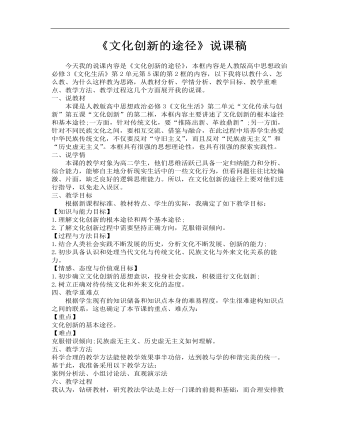
高中思想政治人教版必修三《文化创新的途径》说课稿
二、说学情本课的教学对象为高二学生,他们思维活跃已具备一定归纳能力和分析、综合能力,能够自主地分析现实生活中的一些文化行为,但看问题往往比较偏激、片面,缺乏良好的逻辑思维能力。所以,在文化创新的途径上要对他们进行指导,以免走入误区。三、教学目标根据新课程标准、教材特点、学生的实际,我确定了如下教学目标:【知识与能力目标】1.理解文化创新的根本途径和两个基本途径;2.了解文化创新过程中需要坚持正确方向,克服错误倾向。
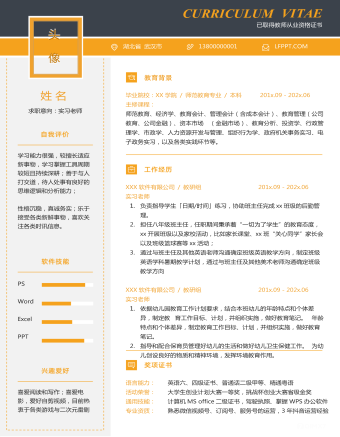
师范英语教师简历
XXX软件有限公司 / 教研组 201x.09 - 202x.06实习老师1. 负责指导学生「日期/时间」练习,协助班主任完成xx班级的后勤管理。2. 担任八年级班主任,任职期间秉承着“一切为了学生”的教育态度,xx开展班级以及家校活动,比如家长课堂、xx班“关心同学”家长会以及班级篮球赛等xx活动;通过与班主任及其他英语老师沟通确定班级英语教学方向,制定班级英语学科暑期教学计划,通过与班主任及其他美术老师沟通确定班级教学方向
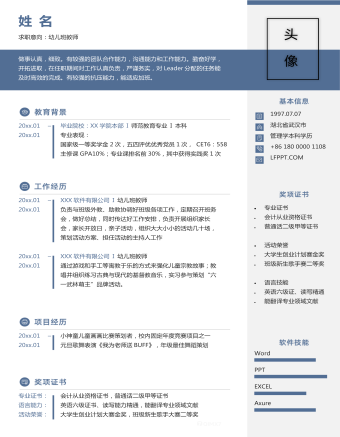
简历英语幼教模板
XXX软件有限公司 I 幼儿班教师负责与班级外教、助教协调好班级各项工作,定期召开班务会,做好总结,同时传达好工作安排,负责开展组织家长会,家长开放日,亲子活动,组织大大小小的活动几十场,策划活动方案、担任活动的主持人工作XXX软件有限公司 I 幼儿班教师通过游戏和手工等寓教于乐的方式来强化儿童宗教故事;教唱并组织练习古典与现代的基督教音乐,实习参与策划“六一武林萌主”品牌活动。
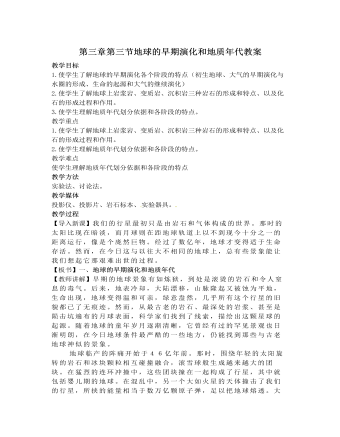
人教版高中地理选修1第三章第一节地球的早期演化和地质年代教案
地质年代可分为相对年代和绝 对年龄(或同位素年龄)两种。相对地质年代是指岩石和地层之间的相对新老关系和它们的时代顺序。地质学家和古生物学家根据地层自然形成的先后顺序,将地层分为5代12纪。即早期的太古代和元古代(元古代 在中国含有1个震旦纪),以后的古生代、中生代和新生代。古生代分为寒武纪、奥陶纪、志留纪、泥盆纪、石炭纪和二叠纪,共7个纪;中生代分为三叠纪、侏罗纪和白垩纪,共3个纪;新生代只有第三纪、第四纪两个纪。在各个不同时期的地层里,大都保存有古代动、植物的标准化石。各类动、植物化石出现的早晚是有一定顺序的,越是低等的,出现得越早,越是高等的,出现得越晚。绝对年龄是根据测出岩石中某种放射性元素及其蜕变产物的含量而计算出岩石的生成后距今的实际年 数。越是老的岩石,地层距今的年数越长。
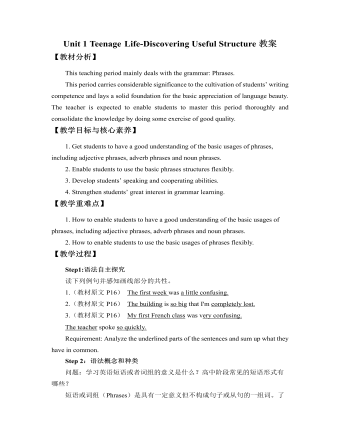
新人教版高中英语必修1Unit 1 Teenage Life-Discovering Useful Structure教案
(形容词短语most beautiful的构成形式为:副词+形容词,该短语在句中作定语修饰名词bird)④A good friend is someone who makes you really happy.好朋友就是能让你真正高兴的人。(形容词短语really happy的构成形式为:副词+形容词,该短语在句中作宾语补足语)[即学即练]画出下例句中的形容词短语并指明构成形式如:It is less cold today than it was yesterday.构成形式: 副词+形容词(1)Our country is becoming more and more beautiful.(2)The road is long enough.(3)The medicine is good for stomach.三、副词短语(Adverb Phrases)副词短语:指以一个副词为中心构成的短语,在句中的功能相当于副词,可以修饰动词、形容词或副词。常见副词短语的构成形式有:(副词)+副词如: much more beautifully①He did his work here yesterday.他昨天在这里工作。(副词短语here yesterday修饰动词did)②Bill did the work very well.比尔做的这份工作很好。副词短语very well修饰动词did③We are all entirely responsible for our action(副词短语all entirely, 修饰形容词短语responsible for)
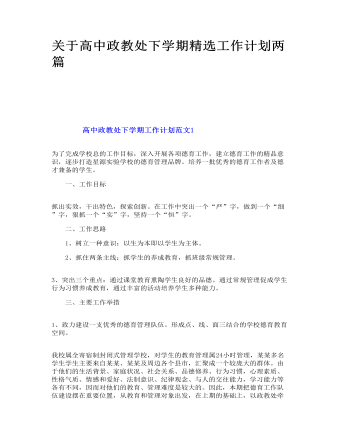
关于高中政教处下学期精选工作计划两篇
1、树立一种意识:以生为本即以学生为主体。 2、抓住两条主线:抓学生的养成教育,抓班级常规管理。 3、突出三个重点:通过课堂教育熏陶学生良好的品德。通过常规管理促成学生行为习惯养成教育,通过丰富的活动培养学生多种能力。
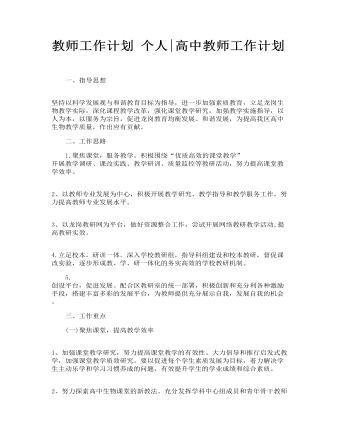
高中教师工作计划
1.聚焦课堂,服务教学。积极围绕“优质高效的课堂教学” 开展教学调研、课改实践、教学研训、质量监控等教研活动,努力提高课堂教学效率。 2、以教师专业发展为中心,积极开展教学研究、教学指导和教学服务工作,努力提高教师专业发展水平。 3、以龙岗教研网为平台,做好资源整合工作,尝试开展网络教研教学活动,提高教研实效。
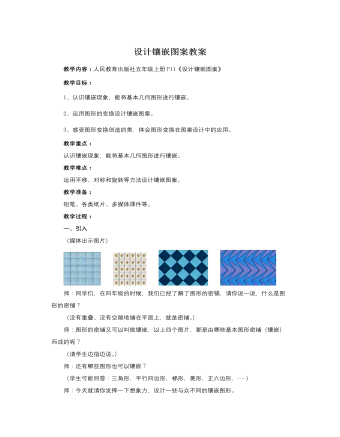
人教版新课标小学数学五年级下册设计镶嵌图案教案
师:同学们,在四年级的时候,我们已经了解了图形的密铺,请你说一说,什么是图形的密铺?(没有重叠、没有空隙地铺在平面上,就是密铺。)师:图形的密铺又可以叫做镶嵌,以上四个图片,都是由哪些基本图形密铺(镶嵌)而成的呢?(请学生边指边说。)师:还有哪些图形也可以镶嵌?(学生可能回答:三角形,平行四边形,梯形,菱形,正六边形,……)师:今天就请你发挥一下想象力,设计一些与众不同的镶嵌图形。[设计意图说明:学生在四年级已经初步了解了图形的密铺(镶嵌)现象,四幅图片是四年级下册教材《三角形》单元中《密铺》内容中的原图。本单元在此基础上,通过数学游戏拓展镶嵌图形的范围,让学生用图形变换设计镶嵌图案,进一步感受图形变换带来的美感以及在生活中的应用。]二、新授探究一:利用平移变换设计镶嵌图形